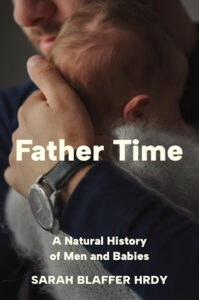
Paternal Instinct: Why Men Go Gaga Over Babies, Too
Sarah Blaffer Hrdy on the Biological and Neurological Impulses That Fuel Parent-Child Bonds
It was a lovely summer afternoon when Sue Carter, one of the world’s experts on oxytocin, and I were taking a country walk. We were deep in conversation when all of a sudden, one of my dogs took off in pursuit of a deer. “Not to worry,” I reassured Sue, “they never catch them.” Moments later we were both horrified as pathetic bleats pierced the air. A 120 pound ridgeback had blundered upon and caught a fawn who must have been lying still, hiding in the grass between the dog and its fleeing mother. I rushed to catch hold of the dog as the fawn wriggled free and raced into a nearby wheat field and out of sight. At that point, the dog broke free of my grasp and charged after it. The whole heartrending episode was soon over, followed by silence. Yet the fawn’s cries continued to reverberate inside us. Shaken, neither of us could speak until I exclaimed: “Sue, it sounded just like a human baby.”
“I know,” Sue replied. “When we tape the distress calls of a baby vole separated from its mother, then slow the calls down and replay them, a baby vole’s cries are indistinguishable from a human baby’s. We’re talking highly conserved, ancient, ancient signals here, and similarly ancient responses in you and me.”
As our overactivated amygdalas settled down, Sue and I began to calmly analyze the situation. Neither of us was surprised that we two mammals, both mothers, by now both grandmothers, had experienced such a powerful response to the fawn’s distress calls. The limbic systems of mother mammals are primed to respond within milliseconds, just as ours had. Our hearts beat faster, our glucocorticoid levels rose, and perhaps vasopressin as well. If we were anything like the prairie vole parents Sue studies in her lab, there would be an enhanced release of oxytocin.
For baby’s cry is a universal signal: “I need attention.” But with sufficient exposure, a mother soon learns to distinguish her own baby’s cries from someone else’s. The selective engagement necessary for a bond to form with one’s very own infant requires more than just a rush of oxytocin: a cocktail of molecules and a particular social or tactile context.
Once that baby begins to soothe or even smile, signaling that all is well, key dopamine-associated pleasure centers light up in our brains—the same regions that in amphibians induce male frogs to transport tadpoles. Mammals that we are, though, maternal emotions suffuse our caring. Reflexively, we smile back, our pleasure exponentially more intense when the contented baby is beloved and our own.
Once a bond is forged, a mother temporarily separated from her young yearns for her little morsel more longingly than a hungry person anticipates a delectable treat, more desperately than an addict craves her next fix. At an evolutionary level, the explanation is simple. Whether wandering across a savanna or deep in a forest, a mother mammal who failed to respond to distress signals from her baby would be unlikely to remain a mother for long. Potential costs of not responding would be catastrophic. Thus does Mother Nature set the bar for responding quite low, relying on neural fail-safes that are widespread.
There is no question that men are readily galvanized by infantile distress cries.
Biologist Susan Lingle and her colleagues at the University of Winnipeg have conducted fascinating experiments showing that mother mule deer respond across species, much as Sue and I did. When the researchers played a human baby’s distress cries, a mother mule deer reacted immediately, approaching the hidden speaker with alarmed concern. The doe was similarly attracted by distress vocalizations from such disparate infant mammals as kittens, baby marmots, seals, or bats. She was not at all attracted by other types of calls, such as the bark of an adult coyote.
No wonder false positives are so common. I can remember many occasions, long after my own children were grown, when I suddenly became alert upon hearing a plaintive call—“Maa-ma!”—uttered by some stranger’s child in the supermarket. Cries are the mammalian infant’s universal appeal for assistance. Sue and I were pre-programmed to respond exactly as we had, even though the piteous cries came not from our own baby, but from a little ungulate.
*
Mammalian mothers and grandmothers are not the only ones whose neural systems are susceptible to cries from a vulnerable baby. Men may be somewhat slower to respond to the whimpering of a baby just rousing from a nap, but respond they do. Amp up whimpers to screams of real distress, and fathers respond with as much urgency as mothers do. This is what Alison Fleming and fellow psychobiologists discovered when they compared how mothers and fathers responded to recordings of a mildly whimpering baby versus piercing screams from a baby being circumcised. The moment the baby’s cries escalated into sounds of real distress, fathers reacted just as fast as mothers did. Notably, it takes infant cries, not just generic human cries from another adult, to elicit this milliseconds-rapid reflex, triggered by emotional centers in the orbitofrontal cortex.
Since it has been widely assumed that human mothers must be instinctively more responsive to their babies than fathers, it was presumed that they would also be better at distinguishing their own babies’ cries. But this is not necessarily so. The title of one of the first studies to carefully test this conventional wisdom summarizes the main finding: “Fathers are just as good as mothers at recognizing the cries of their own baby.”
The study was undertaken by French neuroethologist Nicolas Mathevon and his team at the University of Lyon/Saint-Etienne. They recorded cries of babies aged about two to five months, born either in nuclear families in France or extended families in the Democratic Republic of the Congo. Next, they asked parents to listen to cries of both unfamiliar babies and their own. Some five times out of six, parents correctly identified the cries of their own baby.
The best predictor of success was not the sex of the parent, but how much time either mother or father routinely spent with the baby. Mothers in the study spent at least four hours a day with their babies, while fathers averaged far less time. Fathers most likely to correctly identify their own baby were those who spent more time with them. A follow-up study revealed that the hearer need not even be related to the baby—which earlier reports claiming maternal superiority had failed to control for. What mattered was the amount of time spent with that baby, the adult’s familiarity with the infant.
*
It’s hard to know if the cry of that desperate fawn would have echoed with the same resonance in a man as it did in Sue and me that day. Nor am I sure whether men respond as powerfully as I do to infantile scents like the luscious, utterly alluring scent emanating from a new baby’s scalp, thought to derive from an organic compound known as hexadecanal, or HEX. When I have had occasion to ask fathers whether they find the scent as delectable as I do, some say yes, some no, and others can’t imagine what smell I am talking about.
In one of the few studies to examine responses to newborn baby odors, 15 women who had recently given birth and 15 who never had were scanned while being presented with the scent of a newborn. The same dopamine-related reward centers were activated in the brains of mothers and non-mothers alike. But that study included no men. A later, carefully controlled double-blind experiment undertaken in Israel in 2021 included men, and that study revealed a curious difference in men’s and women’s responses to the HEX scent.
The study at the Weizmann Institute of Science divided 67 men and 60 women into two groups. Half the participants of each sex were exposed to HEX, the other half to other odors. Next, participants were invited to participate in an online contest (an ultimatum game) for cash prizes. Alas for the participants, the game was rigged so as to deliberately frustrate and provoke players by consistently yielding unfair outcomes.
When given just seconds to retaliate against the “unfair person” (really just a computer algorithm) by blasting their opponent with unpleasant noise, the responses of the men exposed to baby scent were far less reflexively aggressive than responses of those who had not been exposed to HEX. Meanwhile, in women players similarly provoked, reflexively aggressive responses were actually increased if they had been exposed to HEX.
The experimenters interpreted their findings to mean that “sniffing babies may increase aggression in mothers but decrease aggression in fathers,” presumably because “maternal aggression has a direct positive impact on offspring survival in the animal world (while) paternal aggression has a negative impact on offspring survival.”
This interpretation is in line with what we know about increased protectiveness and “lactational aggression” in new mothers. However, it is worth noting that none of the scents used in the experiments were from the participants’ own baby. In fact, not all of the participants were even parents. In other words, the attenuated aggressiveness among men exposed to HEX was better accounted for by a general tolerance toward babies than by any specifically paternal response. It was more nearly the sort of generalized “alloparental” response hypothesized by neuroscientists like Eyal Abraham and Ruth Feldman in their experiments with men helping mothers care for babies.
Just for the record, while on the subject of smells, there is no reason to think fathers are any less able than mothers to identify the scent of their own children after living with them for years. In one of the few studies comparing parents on this, fathers were about as accurate as mothers, who successfully recognized their child by scent alone in 79.4 percent of tests presented to them, compared with men, who succeeded 67.7 percent of the time, a difference which was not statistically significant. But this study involved four-year-olds rather than babies, and it’s likely that the two parents were equivalently involved in their care.
Men and women were equally likely to linger over photographs of cute babies, and equally likely to expend effort to do so.
Setting aside questions about similarities and differences in how men and women respond to the smells of babies, there is no question that men are readily galvanized by infantile distress cries, nor much doubt that both sexes respond to other auditory and visual cues. Given equivalent prior exposure, men are just as good as mothers at identifying which baby is crying.
Men as well as women also succumb to alluring infantile traits like big eyes, chubby cheeks, a tiny nose, or a big head attached to a warm and cuddly little body—the traits inspiring “baby lust” that Nobel Prize-winning ethologist Konrad Lorenz summed up as Kindchenschema, from the German Kindchen for “baby” or “little child” and “schema,” referring to a mental representation.
Kindchenschema helps explain why it takes less than a seventh of a second for electrical activity in the medial orbitofrontal cortex, a brain region involved in processing delectable rewards such as favorite foods, to fire off when people look at a cute baby. This is what Oxford neuroscientist Morten Kringelbach and his team discovered when they employed magnetoencephalography, a neuroimaging method, to scan the brains of a dozen men and women as they perused photos of attractive but unfamiliar infant or adult faces. The magnitude of the response was significantly greater when the individual in the photograph was a baby rather than a grown-up.
When Kringelbach published the findings in a paper titled “A specific and rapid neural signature for parental instinct,” the announcement generated its own hyperstimulating effect on the media. One headline blared that the “neural basis for parental instinct” has finally been identified! 26 In fact, once again, only a minority of the men and women whose brains reacted so positively to babies were actually parents.
Additional work by Kringelbach and colleagues revealed that although women were more sensitive to cuteness in general, men and women were equally likely to linger over photographs of cute babies, and equally likely to expend effort to do so. Apparently both sexes find looking at cute babies rewarding. Not long after that, when the Oxford team studied the effects of hearing infantile distress cries and realized that non-parents as well as parents were affected, they started talking about “a universal brain-based caregiving instinct” rather than a “parental” one, which I think is exactly right.
Pretty clearly, neither the hormonal changes of gestation, birth, and lactation nor genetic relatedness are essential to activate the relevant neurons that make little babies (as well as kittens and puppies) extremely attractive. Given that neural circuits mediating responses to babies are present in allomothers as well as mothers, and in mammalian males as well as females, what are they doing there? And what conditions encourage their activation in human males? Might these sensitivities date back to deep time, retentions from phylogenetically ancient molecules and capacities lingering in the brains of both sexes?
__________________________________

From Father Time: A Natural History of Men and Babies by Sarah Blaffer Hrdy. Copyright © 2024. Available from Princeton University Press.
Sarah Blaffer Hrdy
Sarah Blaffer Hrdy is professor emerita of anthropology at the University of California, Davis. She is the author of The Woman That Never Evolved, Mother Nature, and Mothers and Others: The Evolutionary Origins of Mutual Understanding.



















